How are aid budgets changing due to the Covid-19 crisis?
This unique analysis sheds light on how Covid-19 has impacted aid flows using real-time IATI data on aid commitments in the first 5 months of 2020.
DownloadsKey facts
The Covid-19 pandemic has seen unprecedented resource pledges and commitments from the global community, much of which is supplied in the form of official development assistance (ODA). There is an immediate need for these resources to be tracked from the perspectives of both donors and recipient countries, to see how commitments are translated into real assistance. Development Initiatives (DI) is tracking these flows, assessing how assistance is responding to the crisis and how aid trends may be changing. To track these changes in the aid landscape in real time, DI will expand and publish updates in as close to real time as data verification allows.
- Bilateral aid commitments reported to the International Aid Transparency Initiative (IATI) in the first five months of 2020 (US$16.9 billion) are lower than expected and a third less than that of the same period in 2019 (US$23.9 billion).
- Unlike bilateral donors, multilateral donors have increased their commitments published through IATI in the first five months of 2020 (US$48.8 billion) compared with the same period in 2019 (US$28.7 billion) and what would be expected without the crisis.
Figure 1: Total commitments reported to IATI by selected bilateral and multilateral donors in the first five months of 2019 and 2020
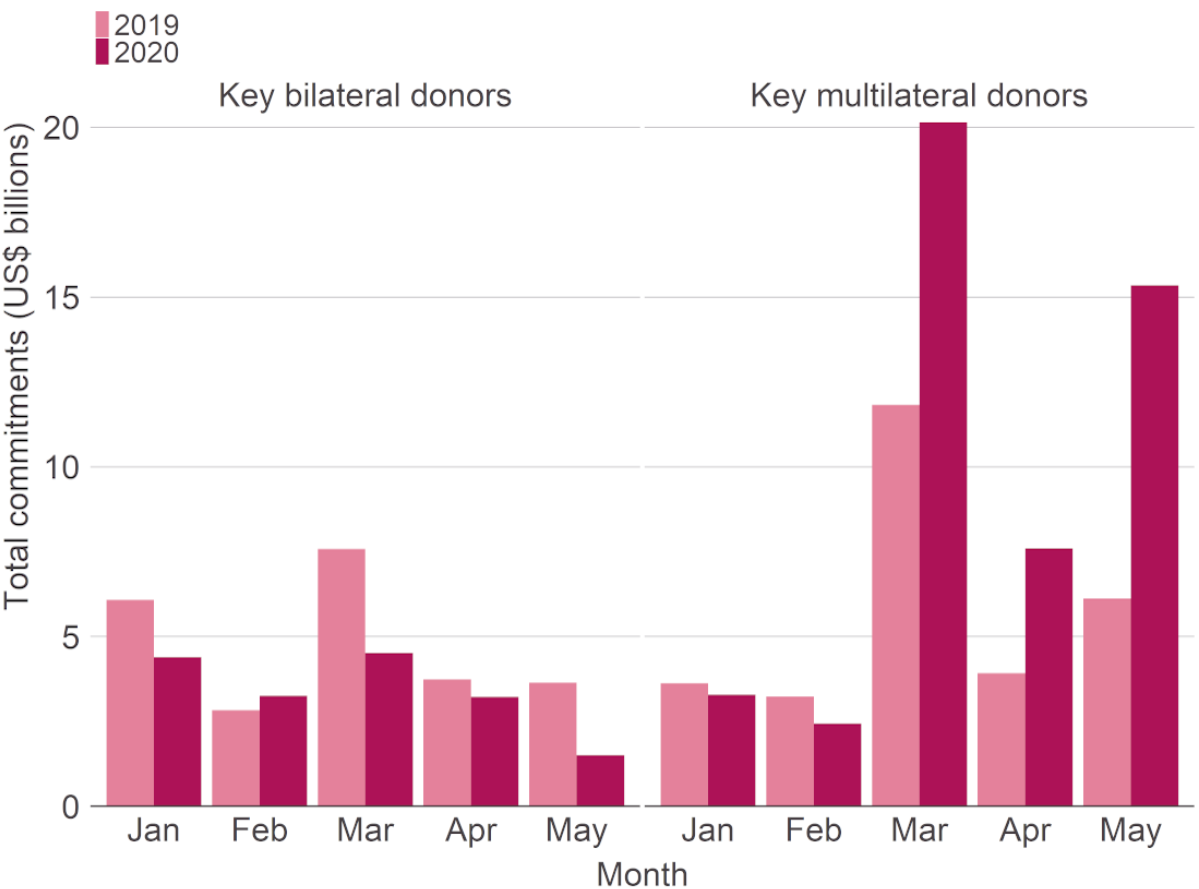
Bilateral aid commitments reported to IATI in the first five months of 2020 (US$16.9 billion) are lower than expected and a third less than that of the same period in 2019 (US$23.9 billion). Unlike bilateral donors, multilateral donors have increased their commitments published through IATI in the first five months of 2020 (US$48.8 billion) compared with the same period in 2019 (US$28.7 billion) and what would be expected without the crisis.
Source: Development Initiatives based on IATI.
- The sectors important for an immediate response see mixed commitment trends: health commitments have remained roughly constant as a proportion of total commitments and water and sanitation commitments as a proportion of total commitments have stayed steady despite the long-term decreasing trend.
Figure 2: Total health commitments reported to IATI by selected bilateral and multilateral donors in the first five months of 2019 and 2020
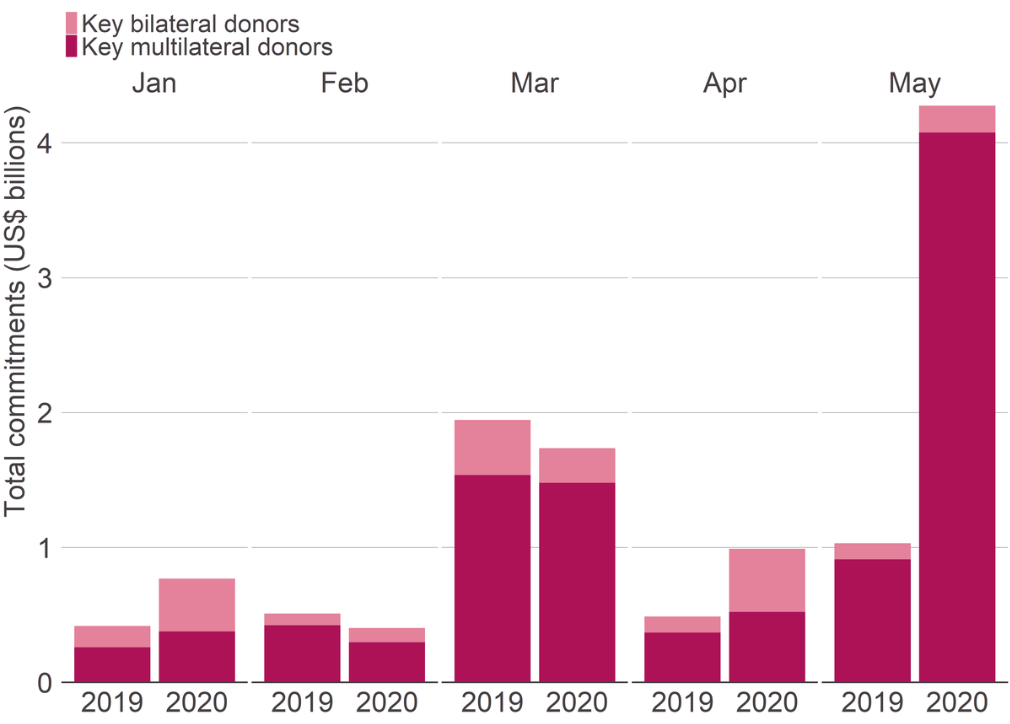
There is a large spike in commitments to the health sector in May 2020. This mainly due to key multilateral donors publishing US$4.1 billion worth of commitments to the sector; the total commitments to the health sector published to IATI in May 2020 (US$4.3 billion) is greater than that of the May 2019 (US$1.0 billion). The next largest month of commitments in 2020 is in March (US$1.7 billion); again, this is largely from key multilateral donors.
Source: Development Initiatives based on IATI.
Figure 3: Total water and sanitation commitments reported to IATI by selected bilateral and multilateral donors in the first five months of 2019 and 2020

Commitments published to IATI in the water and sanitation sector see a large spike in March 2020 (US$3.1 billion), mainly due to commitments by key multilateral donors (US$3.0 billion). The level in March 2020 is much higher than in March 2019 (US$0.8 billion). In all other months in both 2019 and 2020 (up to and including May 2020) commitments are less than US$0.5 billion.
Source: Development Initiatives based on IATI.
- Some donors’ overall commitments have increased in early 2020 (for example, the World Bank, the Global Fund to Fight AIDS, Tuberculosis and Malaria (the Global Fund)) but others have decreased, such as the Department for International Development (DFID), which has “paused some new decisions” and is prioritising “lifesaving aid”.
Introduction
Tracking commitments to the Covid-19 pandemic, along with other transactions, is challenging due to the varying scope and purpose of the available data platforms, many of which have newly implemented Covid-19 marker systems. [1] Unfortunately, these platforms do not provide the whole picture for Covid-specific aid, with many commitments being missed. For example, using IATI, it is not mandatory for donors to mark their commitments as coronavirus related. [2] Furthermore there is no agreed definition of what is meant by a Covid-related commitment. This makes quantifying the effect of coronavirus on aid flows difficult. Various sources produce aid data, including the Organisation for Economic Co-operation and Development (OECD) Development Assistance Committee (DAC) Creditor Reporting System (CRS) and the UN Office for the Coordination of Humanitarian Affairs (OCHA) Financial Tracking Service (FTS). However, this analysis uses IATI because it is the only source which allows tracking of real-time response to changes in both humanitarian and development aid.
Most bilateral donors and large multilateral agencies now publish their aid activities using the IATI data standard. Most refresh their data monthly. This includes details (rather than annual aggregates) of financial transactions. IATI does not maintain a curated database: its datastore is a live repository that refreshes daily based on publishers’ outputs. This means that there is a need for DI analysts to routinely review the consistency of data. Furthermore, IATI contains data published by all participants in the aid delivery chain and the same activity can therefore be reported by donors, fund managers and implementing agencies. Care therefore needs to be taken in aggregating finances – particularly between bilateral donors and multilateral agencies. Notwithstanding these limitations, the demands of the pandemic response are beginning to show the benefit of a standard that has been built around the need for timely, comprehensive and forward-looking open data on development and humanitarian resource flows.
To create a picture of how global aid has been affected by the Covid-19 crisis, DI has developed a model which takes the commitments published to IATI since 2015 by the key multilateral and bilateral donors reporting to IATI, [3] covering 70.0% of total commitment value. This model is used to compare commitments in the first five months of 2020 to those which would have been expected during this period assuming no major external factors had changed (that is, no Covid-19 crisis). This model accounts for the aid commitment trends since 2015 and seasonal fluctuations in reporting. Comparing the difference in commitments published to IATI in 2020 with the expected value based on previous years shows the likely effect of coronavirus on aid flows. This paper also compares to the previous year to illustrate immediate changes.
Global analysis
Using the past five years of data for key donors, this analysis estimates the range of values for commitments and a range where the commitment value can be reasonably expected to sit in 2020, provided external factors stay constant . Clearly, the Covid-19 pandemic is a severe change in the external environment and if it is considered the only large discrepancy in circumstances compared with previous years, a change in commitment value to outside of the reasonable range can be considered to be a significant change caused by the Covid-19 crisis.
Bilateral aid commitments reported to IATI in the first five months of 2020 are lower than expected and a third less than the same period in 2019
Figure 4: Total commitments reported to IATI by selected bilateral donors

Bilateral aid commitments reported to IATI in the first five months of 2020 are lower than expected and a third less than the same period in 2019. In particular, in March, the actual value of commitments (US$4.5 billion) was significantly lower than the expected value (US$8.5 billion).
Source: Development Initiatives based on IATI.
Notes: The error bars denote the 90% confidence interval for commitment value from the selected multilateral donors in 2020. Where the actual value is outside this range, this is considered a statistically significant change.
During the first five months of 2020, aid commitments from the largest bilateral organisations have been lower than expected (US$16.9 billion rather than US$20.8 billion) (Figure 4). Such levels are roughly a third less than the total commitments observed in the first five months of 2019 (US$23.9 billion). In particular, in March, the actual value of commitments (US$4.5 billion) was significantly lower than the expected value (US$8.5 billion) based on reporting in previous years. Why have reported commitments by bilateral organisations not remained as expected in this time frame? It is possible that bilateral actors are paying the economic price of Covid-19 (such as bailouts, stimulus measures, loss of revenue) and have reduced commitments due to the uncertainty. DI will monitor this to observe the change in bilateral commitments over the remainder of the year, publishing updates in as close to real time as data verification allows.
Unlike bilateral donors, multilateral donors increased their commitments published through IATI in the first five months of 2020 compared with the same period in 2019 and what would be expected without the crisis
Figure 5: Total commitments reported to IATI by selected multilateral donors
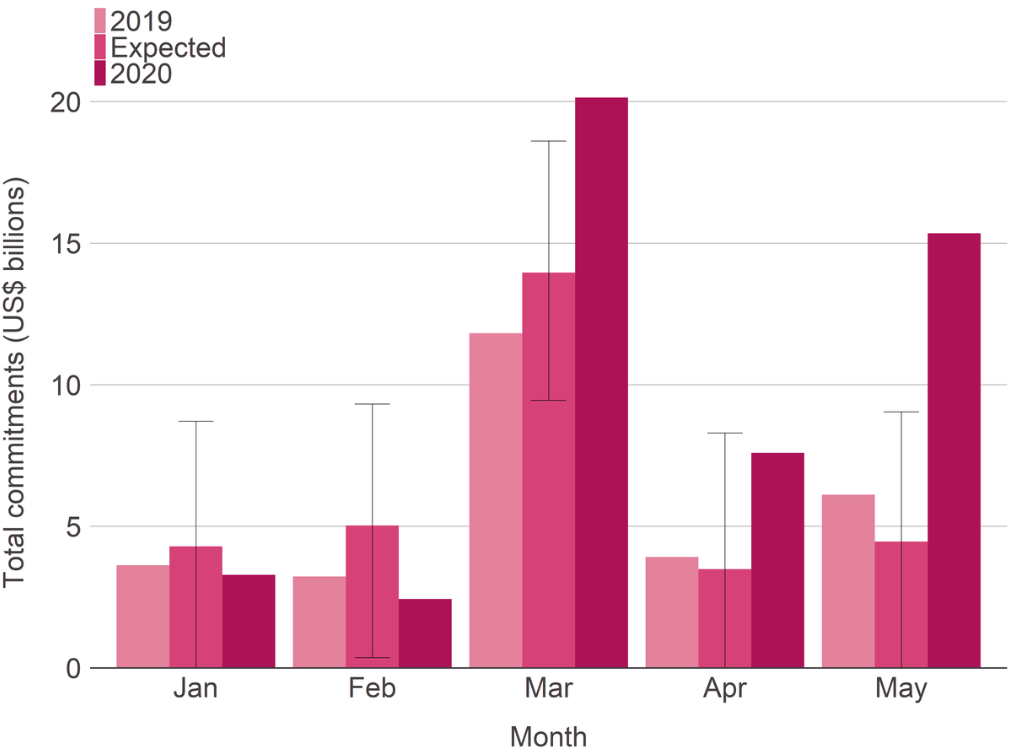
Actual commitments are greater in early 2020 compared with what would be expected without the crisis. In particular, commitments in March and May 2020, US$20.1 billion and US$15.3 billion respectively, are significantly greater than expected.
Source: Development Initiatives based on IATI.
Notes: The error bars denote the 90% confidence interval for commitment value from the selected multilateral donors in 2020. Where the actual value is outside this range, this is considered a statistically significant change.
A different trend is observed when looking at the largest multilateral organisations – actual commitments are greater in early 2020 compared with what would be expected without the crisis (Figure 5). This may be due to continuity of existing programmed work and multilateral organisations not yet being hampered by the budget constraints felt by donor governments. Actual commitments stood at US$48.8 billion: 56.3% greater than the expected commitments from the model (US$31.2 billion) and 70.0% greater than the level of commitments in 2019 (US$28.7 billion).
Noticeably, soon after the UN and other large multilateral organisations called for countries to “scale up their efforts to combat the coronavirus pandemic” in March 2020, commitments from large multilaterals increased considerably . In March and May 2020, there was a significant increase in aid commitments by large multilateral organisations – respectively US$6.2 billion and US$10.9 billion more than expected. In April, total commitments increased by US$4.1 billion on what was expected,
It is positive that the value of multilateral commitments has matched and, in March to May, exceeded that expected, but it must be sustainable to tackle the whole crisis. DI will continue to monitor and publish future commitments by donors to see whether this effort is sustained as the Covid-19 crisis and its effects continue to unfold. DI will also track actual disbursements to observe whether they align with commitments made or whether commitments were front-loaded into the early months of 2020.
Sector analysis
Are the same trends in commitments seen across each of the sectors important for the immediate effects of the crisis? To initiate DI’s real-time sectoral assessment of aid, this paper looks at health and water and sanitation, both as a percentage of total ODA from specified donors and the absolute commitment value trends already discussed.
It is widely agreed that beyond financial tools such as debt relief, developing countries will need immediate healthcare provision and investments in systems to cope with the Covid-19 crisis. Indeed, in 2017 average annual health spending per person was US$41 in low income countries compared with US$2,937 in high income countries. [4]
Multilateral aid commitments in aggregate have increased above expected levels in the first five months of 2020 but are these funding the health sector in developing countries?
The proportion of aid to the health sector by key multilateral donors in the first five months 2020 is roughly the same as in previous years. Overall aid to the sector has increased in this period compared with 2019
Figure 6: Monthly health commitments by key multilateral donors as a proportion of total commitments with annual trend line, 2015–2020

The proportion of aid to the health sector by key multilateral donors in the first five months of 2020 is roughly the same as in previous years. There are spikes - in April and July 2015, and August 2016 - where health aid represents 15% or more of total commitments.
Source: Development Initiatives based on IATI.
Notes: Annual trend line is a calendar year average.
Analysing the same set of large multilateral organisations as above, the percentage of all ODA commitments which were specified to the health sector in the first five months of each year between 2015 and 2019 stood at 3.5%. In the first five months of 2020, the percentage of ODA to the health sector stands at 4.4%. This suggests the proportion of aid to health – one that has remained reasonably constant since 2010 is being sustained. As overall multilateral commitments have increased in the first five months of this year (Figure 1), health commitments from multilaterals in absolute value have also increased. DI will continue to monitor the proportion of aid commitments to health to observe whether this trend continues in light of the Covid-19 crisis.
Looking at health commitments by the largest bilateral donors, a proportional increase in the first five months can be seen compared with previous years: 5.0% between 2015 and 2019 but up to 8.7% in 2020. However, there has not been the same quantity of commitments from bilateral donors (Figure 1), hence the absolute value of commitments from bilateral donors is not considerably greater than expected. Whether this changes in later months will require monitoring and therefore DI will update this analysis regularly.
In the first five months of 2020 the proportion of aid going to water and sanitation is roughly the same as in the same period in 2019, however it fluctuates considerably monthly
Water and sanitation is another key sector in dealing with the immediate elements of the Covid-19 crisis. While health system strengthening is an important factor for dealing with the Covid-19 pandemic, there is a growing school of thought that, due to the wide prevalence of illnesses such as malnutrition and tuberculosis in developing countries, the high recovery rate seen in other parts of the world is not replicated. Preventative measures are therefore needed to avoid straining developing countries’ limited health systems. [5] One of these measures is access to functioning handwashing facilities with water and soap, which an estimated 3 billion people do not have. [6]
Figure 7: Monthly water and sanitation commitments by key multilateral donors as a proportion of total commitments with annual trend line, 2015–2020
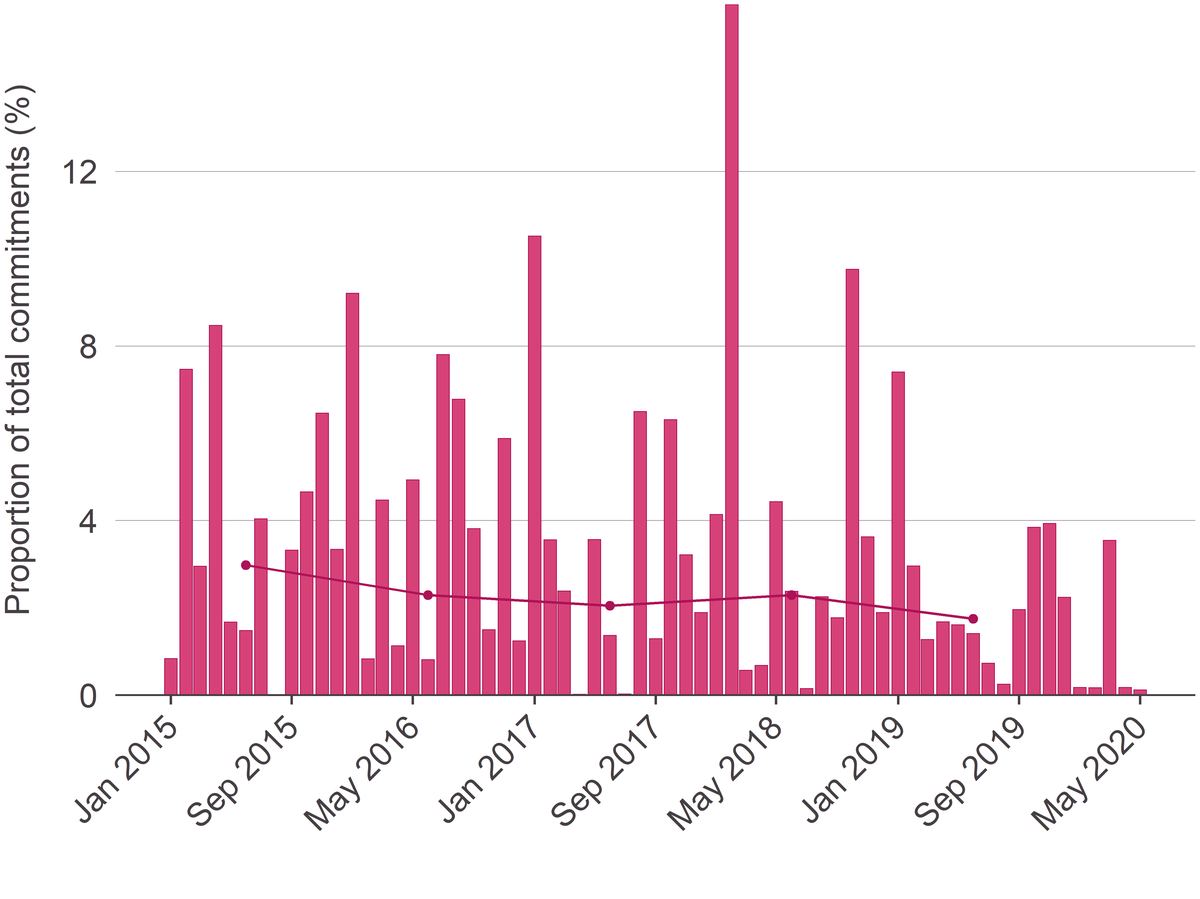
In the first five months of 2020 the proportion of aid going to water and sanitation is roughly the same as in the same period in 2019. There are large fluctuations monthly. Water and sanitation aid as a proportion of total commitments peaks in February 2018 at 15.8%.
Source: Development Initiatives based on IATI.
Notes: Annual trend line is a calendar year average.
The percentage of multilateral ODA commitments which were specified to the water and sanitation sector in the first five months of each year between 2015 and 2019 stood at 2.6%. In the first five months of 2020, the percentage of ODA to the sector was 2.0%. Commitment values to this sector have fluctuated greatly across the time period in question due to a changing number of publishers across the time period [7] hence DI will closely monitor commitments over the longer term to see if this decrease is rectified. Despite slight decreases in proportion of commitments dedicated to the water and sanitation sector, due to the increase in overall multilateral commitments, the absolute value of multilateral water and sanitation commitments has increased in the early months of this year compared with the same time in 2019.
As for the commitments to water and sanitation by the largest bilateral organisations, [8] a modest increase in their percentage in the first five months can be seen compared with previous years: 1.9% between 2015 and 2019 up to 2.3% in 2020. The absolute value of commitments is lower than expected due to the low bilateral commitment values observed (Figure 1) so DI will monitor this to see whether the overall commitment value to the sector continues to fall or whether there is a recovery.
Donor analysis
Some donors have seen an increase in value of commitments in the early months of 2020 and some have seen sharp declines. This section analyses some key donors which have seen considerable changes.
The World Bank has tripled its commitments published to IATI in the first five months of 2020 compared with the same period in 2019
Figure 8: Commitments published to IATI by the World Bank between January and May, by year
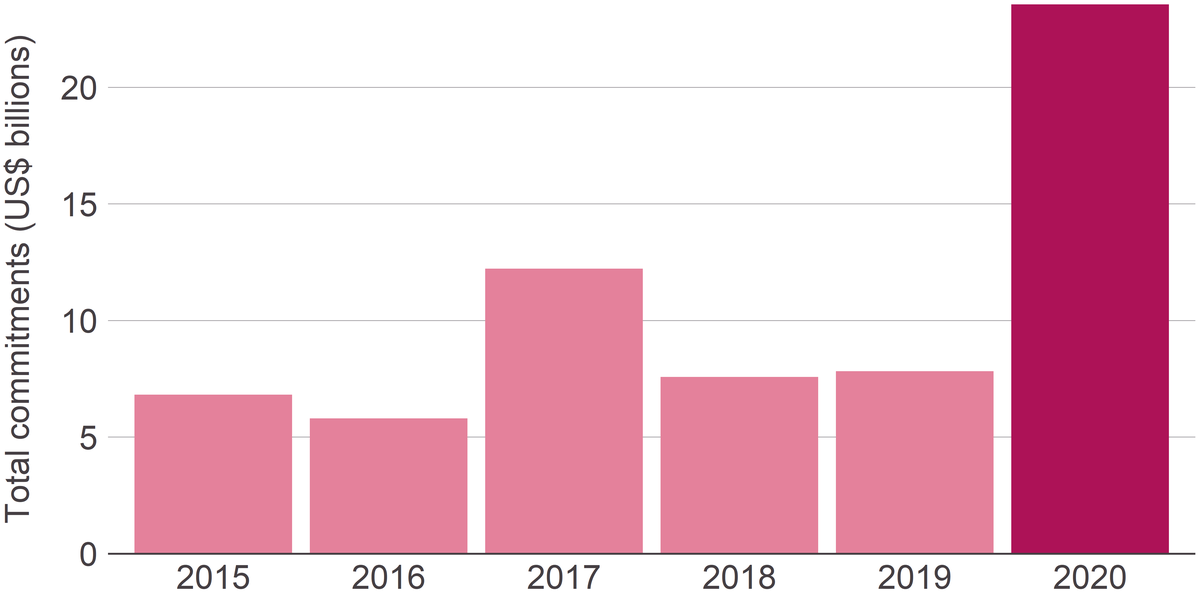
The World Bank has tripled its commitments published to IATI in the first five months of 2020 compared with the same period in 2019, representing a six year peak (US$23.6 billion). In all years previous to 2020 total commitments have stayed roughly same, peaking in 2017 at US$12.2 billion.
Source: Development Initiatives based on IATI.
The World Bank is a key donor in driving the Covid-19-related increase in commitments in the first five months of 2020 outlined earlier. In these five months, World Bank commitments totalled US$23.6 billion, triple its commitments in the same period in 2019 (US$7.8 billion). The commitments published this year were US$11.3 billion greater than the next highest in the period (2017, US$12.2 billion). While the World Bank tends to publish its largest volume of commitments in June, it still publishes a significant amount before May, often mostly in March. Of the last six years, 2020 saw the largest volume of commitments being published by the World Bank in March (US$13.9 billion). This year, for the first time in the six-year period, the World Bank published commitments in May (US$9.7 billion), potentially suggesting that the World Bank are contently rapidly allocating funds due to the Covid-19 crisis.
The Global Fund has also increased its commitments in the first five months of 2020 compared with 2019
Figure 9: Commitments published to IATI by the Global Fund between January and May, by year
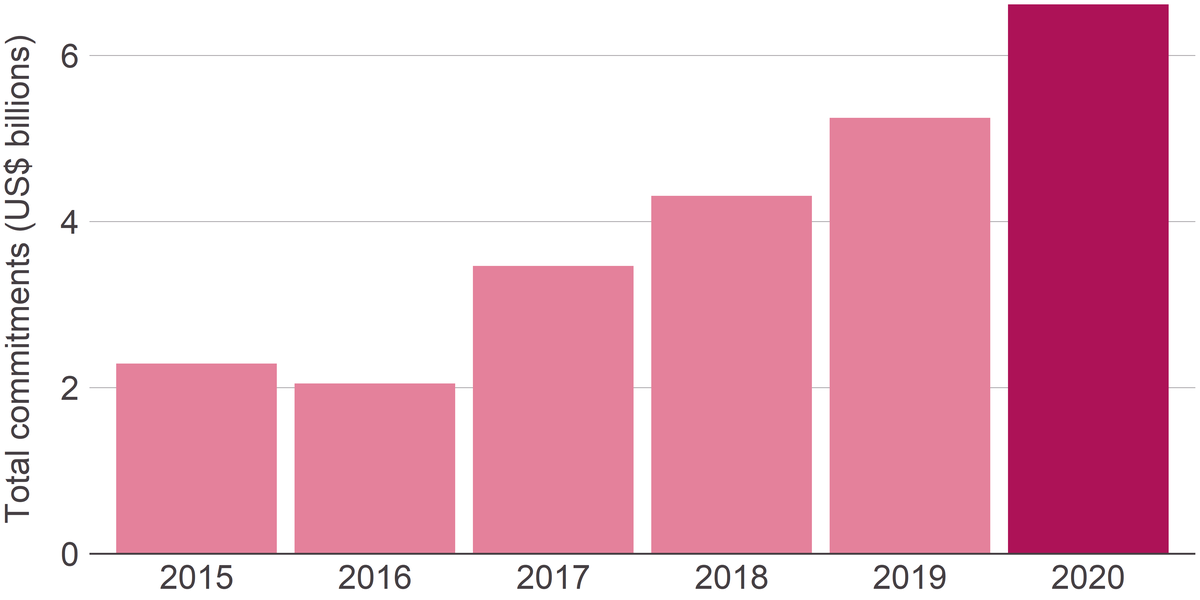
Commitments by the Global Fund have largely increased year-on-year between 2015 and 2020. 2020 represents a six year peak for commitments published to IATI by the Global Fund between January and May (US$6.6 billion).
Source: Development Initiatives based on IATI.
The Global Fund, the third largest multilateral donor in the first five months of 2020, has committed US$6.6 billion, up by quarter (26.0%) on 2019 commitments of US$5.2 billion during the same period. However, it is likely that not all of this is new funding. The Global Fund has allowed donors to repurpose up to 5% of, and use savings from, existing grants. [9] Similarly, some of what the World Bank has pledged towards coronavirus support is not newly pledged funding. Of the initial US$12 billion pledged by the World Bank, only US$8 billion is new money. [10]
UN OCHA country-based pooled funds (CBPFs) have reduced their commitments in the first five months of 2020 compared with 2019
Figure 10: Commitments published to IATI by UN OCHA CBPFs between January and May, by year
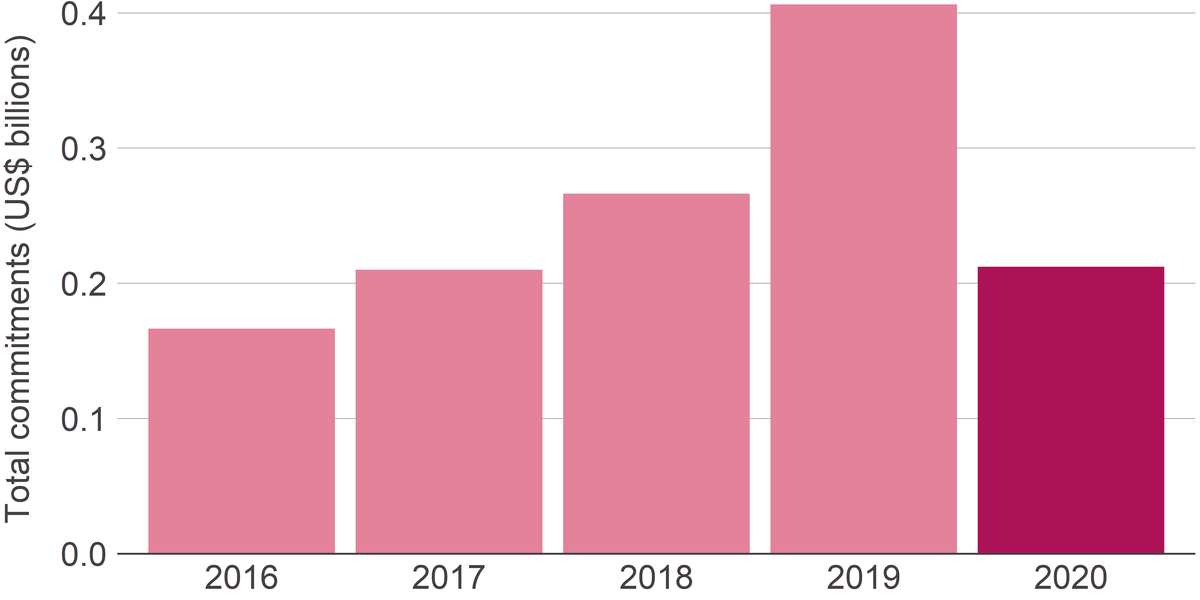
There is a decrease in the value of commitments published to IATI between January and May by UN OCHA CBPFs between 2019 and 2020; 2020 levels are roughly similar to those in 2017.
Source: Development Initiatives based on IATI.
UN OCHA CBPFs have decreased their level of commitments reported through IATI between January and May in 2020 and the same period in 2019. In the January to May 2020 period, commitments by UN OCHA CBPFs were US$212.1 million, compared with US$406.1 million in 2019. This may be due to bilateral donors disbursing more to UN OCHA’s Coronavirus disease Outbreak appeal [11] as opposed to CBPFs, since total UN OCHA appeal requirements are US$9.4 billion higher in 2020 than in 2019. [12]
DFID has greatly reduced its commitments in the first five months of 2020 compared with 2019, pausing all non-“lifesaving” aid due to the Covid-19 crisis
Figure 11: Commitments published to IATI by DFID between January and May, by year
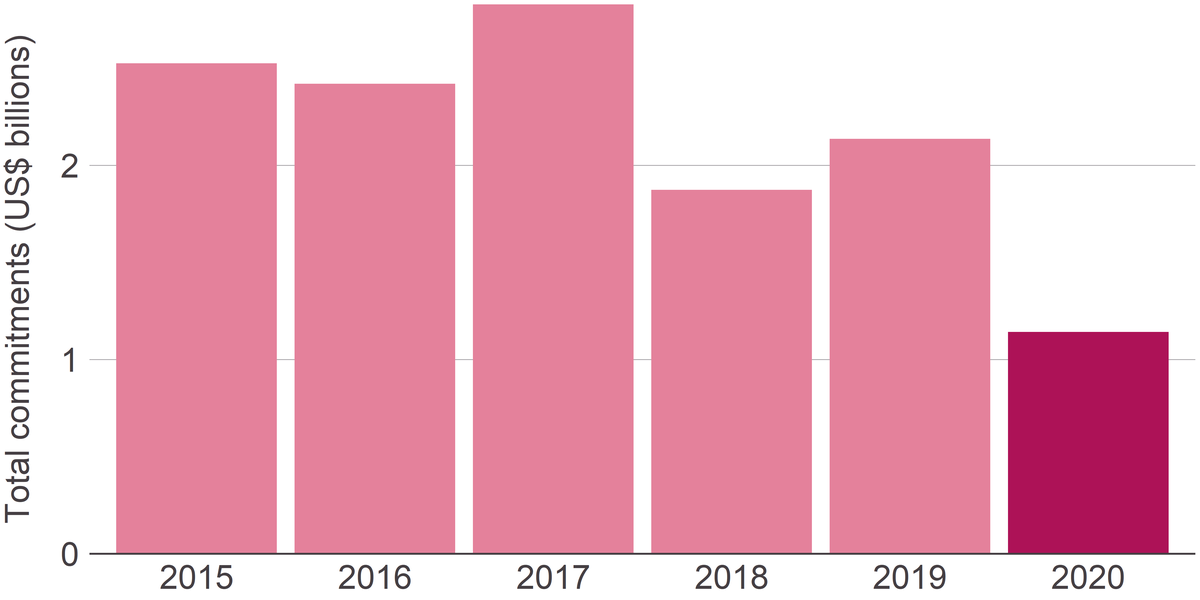
Commitments published to IATI by DFID between January and May reached a six year minimum in 2020 (US$1.1 billion). This is more than half of the six year peak in 2017 (US$2.8 billion).
Source: Development Initiatives based on IATI.
DFID is one of the key bilateral donors to have decreased commitments published to IATI between January and May compared with previous years. In the first five months of 2020 DFID published US$1.4 billion of commitments to IATI. This is a decrease of 46.5% compared with the same period in 2019 (US$2.1 billion). The UK has pledged £744 million (US$941 million) of aid to tackle Covid-19. [13] Of this, around £211 million (US$279 million) is being disbursed through the DFID-administered ODA Crisis Reserve; therefore, commitments will be published through IATI by DFID. Of the total, £130 million (US$162 million) has been pledged to the UN's Global Humanitarian Response Plan for COVID-19, and therefore will not be included in the UK’s commitments published to IATI. Rather, this will be published to FTS, highlighting the difficulty in effectively tracking aid in the Covid-19 crisis. However, it is hard to confirm this due to the mismatch in reporting between IATI and FTS. DFID is pausing non-“lifesaving” aid during the Covid-19-crisis. [14] This is the likely cause of the fall in DFID’s publishing of commitments to IATI in the first five months of 2020, where most commitments are considered “lifesaving” or are related to the Covid-19-crisis. [15]
Conclusion and future analysis
The trends in aid commitments show an overall increase in spending over the early months of 2020, much of which can be considered a likely response to the Covid-19 crisis. In the early stages of the crisis, it is vital that this aid is targeted in the correct areas such as the water and sanitation and health sectors, but evidence of this increase is yet to be observed. Some large multilateral organisations such as the World Bank and the Global Fund have increased their specific commitments from previous years in the face of this crisis, but many are lagging behind on giving details of what activities they will support. However, the economic fallout from the Covid-19 crisis is going to be greater than the immediate health impact. In Kenya, it is predicted that in the very worst-case scenario over the next year, ten thousand people will die of Covid-19. [16] In comparison, in October 2019, poverty was expected to decrease in Kenya in 2020 but as of April 2020, it is expected that nearly a further million people will fall below the $1.90 poverty line. [17] Therefore, it is important that there is also strong data on commitments to areas relating to long-term economic recovery.
In a rapidly changing environment with ever-changing needs, it is important that donors report, and correctly mark, their commitments in a timely manner. Some donors have reported their commitments specifically, however more granularity is needed from most. As more donors mark their activities as coronavirus related, analysis of aid committed specifically to tackling the Covid-19 crisis will become possible and, more importantly, reliable. As this takes place, DI will track, in as close to real time as data validation allows, the allocation of aid by donors to Covid-related areas, and its modality.
Appendix 1 – Methodology
This section outlines the methodology used in this analysis to create a picture of how global aid is being affected by the Covid-19 crisis.
Initial dataset
This paper analyses transactions published to IATI. A direct download was taken (on 10 July 2020) of all the data in the IATI registry. [18] These transactions are filtered by:
- the year 2015 onwards
- commitments only (transaction type marked as ‘C’ or ‘2’)
- key multilateral and bilateral donors reporting to IATI (see Table A1-1), covering 74.9% of total commitment value, [19] based on IATI’s publisher statistics and annual spend.
Table A1-1: Key bilateral and multilateral donors used in the analysis of IATI commitments
| Bilateral donors | Multilateral donors |
|---|---|
| Australia – Department of Foreign Affairs and Trade | African Development Bank |
| Belgian Development Cooperation | Asian Development Bank |
| EU institutions | European Bank for Reconstruction and Development |
| Finland – Ministry for Foreign Affairs | Food and Agriculture Organization of the UN (FAO) |
| France – Ministry for Europe and Foreign Affairs | Global Fund |
| Germany – Federal Foreign Office | Inter-American Development Bank |
| Germany – Federal Ministry of Economic Cooperation and Development (BMZ) | International Fund for Agricultural Development (IFAD) |
| Global Affairs Canada | UN OCHA country-based pooled funds |
| Netherlands – Ministry of Foreign Affairs | UN Children's Fund (UNICEF) |
| Swedish International Development Cooperation Agency (Sida) | UN Development Programme (UNDP) |
| Swiss Agency for Development and Cooperation (SDC) | UN World Food Programme (WFP) |
| Norwegian Agency for Development Cooperation (NORAD) | World Bank Group |
| UK Department for International Development (DFID) | World Health Organization (WHO) |
| US Agency for International Development (USAID) | |
| US Government Foreign Assistance |
All the transaction data pre-2020 has been adjusted to be in constant 2019 US dollars. Due to the Covid-19-related instability of economies it is not currently possible to reliably rebase 2020 data. Therefore, this has been left in 2020 US dollars. However, as this data is only for the first five months of 2020 there is unlikely to be any significant difference in the 2020 and 2019 US dollar data.
In the initial dataset, transactions were split by sector, specifying the OECD DAC vocabulary (‘1’ or ‘2’) for consistency. The key multilateral and bilateral donors all report to the OECD DAC vocabulary. For health, all codes starting with ‘120’, ‘121’ or ‘122’ are included, and for water and sanitation, all codes beginning ‘140’.
Analysis
This data was then used in two ways: 1) comparing current with past values (absolute and proportional); and 2) comparing expected values with actual values observed. These can be used in harmony when drawing conclusions from the data. Due to the quantity, quality and breadth of data, expected values have been produced only at an overall level for key multilateral and bilateral donors. The following sections outline the methodology for each of these in turn.
First, comparing the level of commitments between January and May 2020 to the same period in previous years shows how Covid-19 has changed the ODA landscape. Without Covid-19, commitments in 2020 could be expected to be similar to the previous five years. Any considerable increase or decrease to the level of commitments published to IATI is likely to be due to the Covid-19 crisis and the response of donors. By comparing the proportion of commitments which are marked as committed to key sectors (such as water and sanitation and health), it is also possible to see if donors have changed which sectors their aid flows are going to, regardless of how their absolute volume changes. Second, a Bayesian structural time series (BSTS) model has been used to forecast the overall commitment value which would be expected during this period assuming no major external factors have changed (that is, no Covid-19 crisis). BSTS is a good choice in this case since it has exact small sample results and it is particularly natural for prediction. [20] Despite previous year comparisons showing a potential change in ODA, it does not consider whether this change would be expected given time trends. This model accounts for the aid commitment trends since 2015 and seasonal fluctuations in reporting. Comparing the difference in commitments published to IATI in 2020 with the expected value based on previous years shows the likely effect of Covid-19 on aid flows over and above any changes that would likely have occurred anyway.
Downloads
Notes
-
1
Development Initiatives, 2020. The challenges of data on the financing response to Covid-19. Available at: /publications/challenges-data-financing-response-covid-19Return to source text
-
2
IATI's response to 19 pandemic, https://iatistandard.org/en/news/iatis-response-covid-19-pandemic (accessed 30 June 2020)Return to source text
-
3
See Appendix 1 – Methodology for full list of donors and methods used.Return to source text
-
4
World Health Organization (WHO), 2019. Global Spending on Health: A World in Transition. Available at: www.who.int/health_financing/documents/health-expenditure-report-2019.pdf?ua=1Return to source text
-
5
Why Sub-Saharan Africa needs a unique response to COVID-19, www.weforum.org/agenda/2020/03/why-sub-saharan-africa-needs-a-unique-response-to-covid-19/ (accessed 30 June 2020)Return to source text
Related content
Animated summary: Global Humanitarian Assistance Report 2020
This animated summary unpacks the key statistics and analysis from the Global Humanitarian Assistance Report 2020.
Strengthening data-driven transparency in response to Covid-19
Liz Steele and Mark Brough share DI's experience of developing a new Covid-19 data visualisation, including incentives for organisations to improve the quality of the data they are publishing.
The challenges of data on the financing response to Covid-19
This paper, examining the challenges of using financing data sources, launches our series on matching resources to needs in the global Covid-19 response.